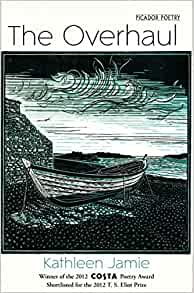The Overhaul
Renfrewshire-born Kathleen Jamie, Scotland’s sole Eliot prize nominee, has long been resident on the Fife shore of the Tay. The Overhaul bears the watermarks of her adopted home.
Jamie’s collection begins with “The Beach”, human rubbish seen as man’s contribution to natural beauty, and comes full circle with the span of “bird-bones, rope-scraps” in the “cursory sketch” of “Materials”. She explores perspectives and the reinvention of identity through her juxtaposition of old and new in language as well as aesthetics; we delve into history in “Excavation & Recovery”. Five sonnets are focused on the Tay (the sonnet, of course, so often takes the form of a love song), and each one develops a certain nostalgia that is perhaps common to the feeling of travellers the world over. The sequence flows river-like, absorbing both the watery environment and humans on the banks.
“The Whales” captures Jamie’s desire to sink into ocean depths, away from people “moaning / and wringing out their beards” and her wish to teach herself to listen … to absorb her surroundings. This poem showcases her natural flair for combining personal and natural worlds, as well as her ability to make sharp comment on society. Her work has attracted attention and expectations concentrated, perhaps unfairly, on her gender and nationality. These contribute to misunderstandings and social pressures which the writer finds suffocating, heard in this poem’s final lines; “tell me you’d look out for me, / down there it’s impossible to breathe – “.
Jamie’s language, her rhythm and tone, swings comfortably between English and Scots. When asked about this in The Guardian interview in 2005, she observed that some words “don’t sit right on the tongue” and that her writing in Scots is designed to “keep it flavoursome”, to keep “the texture of it in the mouth”. These Scots interjections may be single words set within standard English or full poems, written to contort and concentrate both the tongue and the mind, and speak to the complications surrounding cultural identities that develop throughout the book.
If Jamie moves seamlessly between national and personal themes, the observation of nature powerfully underscores all of her poems. Nature is palpable, and every poem is charged and saturated with the sounds, colours and imagery of sea, sky and animals. Each poetic line invokes a personal connection, a symbiosis or a discord between nature and humanity, and is mirrored in our own relationships.
The collection closes on a meditative note; the structure and syntax coming together to form a whole. Here are the strands of initial ideas, ” a bit o’bruck’s all we need to get us started” (“Materials”), then progressively naturalised as meaningful poetry or prose: a chase to “an unsung cleft in a rock, a place you would take to,/dig yourself in”. Jamie compares a completed project to a group of people who have spent all day wandering, collecting and sketching on the beach – their art and their ideas are all that will be left behind. Such a comparison echoes the tone of that titular poem: small beginnings, projects completed and a homage to the working, creative journey ” its a time-of-life things,/ its a waiting game -/ patience, patience” (“The Overhaul”).
Internationally travelled and acclaimed, Kathleen Jamie makes concise comment on today’s changing world. She draws on history and tradition to inform and nurture her writing, but is not adverse to questioning (or reinventing) their contemporary relevance. As in her previous work, she speaks to and for her generation with a relevance and integrity which will be understood and appreciated by non-scholars and academics alike.
Sam Turner


Leave a Reply